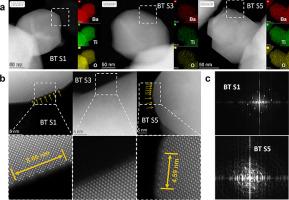Vacancy engineering for high tetragonal BaTiO3 synthesized by solid-state approaches
Abstract
Conventionally, tetragonality in BaTiO3 powder is attributed to grain size, disregarding the role of Ba/Ti ratio. However, our study reveals a significant impact of Ba/Ti ratio on tetragonality in BaTiO3. With an increase in Ba/Ti ratio from 0.990 to 1.010, particle size remains around 200 nm. Tetragonality initially rises from 1.006 to a maximum of 1.0092 at Ba/Ti = 1.000, then decreases to 1.005. Lower tetragonality is associated with Ba or Ti vacancies, using density functional theory (DFT), we analyzed the electron density and lattice distinction in BaTiO3 powders. Both Ba and Ti vacancies affect lattice distortion, the Ti vacancies leading to more significant lattice expansion and lower tetragonality than Ba vacancies. Using this powder, we fabricated high-density BaTiO3 ceramics and multi-layer ceramics capacitors (MLCCs) with X7R temperature stability (−55 to 125 °C, ±15% coefficient) and excellent reliability. This strategy has broad implications for tetragonal BaTiO3 nanopowders and MLCCs development.


| 公司名称 | 产品信息 | 采购帮参考价格 |
|---|
 求助内容:
求助内容: 应助结果提醒方式:
应助结果提醒方式:


